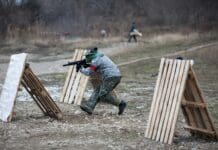This post is also available in:
 עברית (Hebrew)
עברית (Hebrew)
The US Army has begun integrating AI-assisted target recognition into its Next Generation Command and Control (NGC2) prototype during the ongoing Ivy Sting 2 exercise. The new capability is designed to accelerate the identification of battlefield targets and streamline fire missions.
During the exercise, AI models were trained to recognize “hulks”, which are old or decommissioned vehicles on the range, allowing the system to identify them as tanks and generate corresponding fire orders. This marks the first time AI-aided targeting has been tested at this scale within the 4th Infantry Division’s iterative NGC2 experiments.
The Ivy Sting series is intended to gradually increase complexity, moving from limited-range testing at the platoon or battalion level toward division-scale integration planned for next summer’s Project Convergence. The first iteration of the exercise relied on a single observer and a drone for target acquisition and battle damage assessment, connected through the beta Artillery Execution Suite (AXS) tool. Ivy Sting 2 expands this setup to include multiple weapons and more distributed command-and-control nodes.
The current AI system can reliably identify single targets, while future iterations will focus on distinguishing multiple threats simultaneously. Human operators remain an integral part of the process, validating AI-generated assessments and ensuring precision in targeting.
Ivy Sting 2 also introduced six distributed C2 nodes across the training area, combining edge computing and networked communications to stress-test the system’s performance under complex operational conditions. The exercise features three artillery guns, up from one in the previous exercise, with plans to further expand firepower in Ivy Sting 3.
According to Breaking Defense, beyond battlefield targeting, the NGC2 framework is informing broader Army operations, including cybersecurity and data integration. By breaking down barriers between tactical and enterprise data, the system allows information to be shared across all echelons in near real time, significantly reducing the time needed to field new capabilities.
The approach emphasizes not just adopting new technologies, but reshaping operational procedures to leverage AI and networked systems in fundamentally different ways, aiming to improve both decision-making and battlefield efficiency.


























